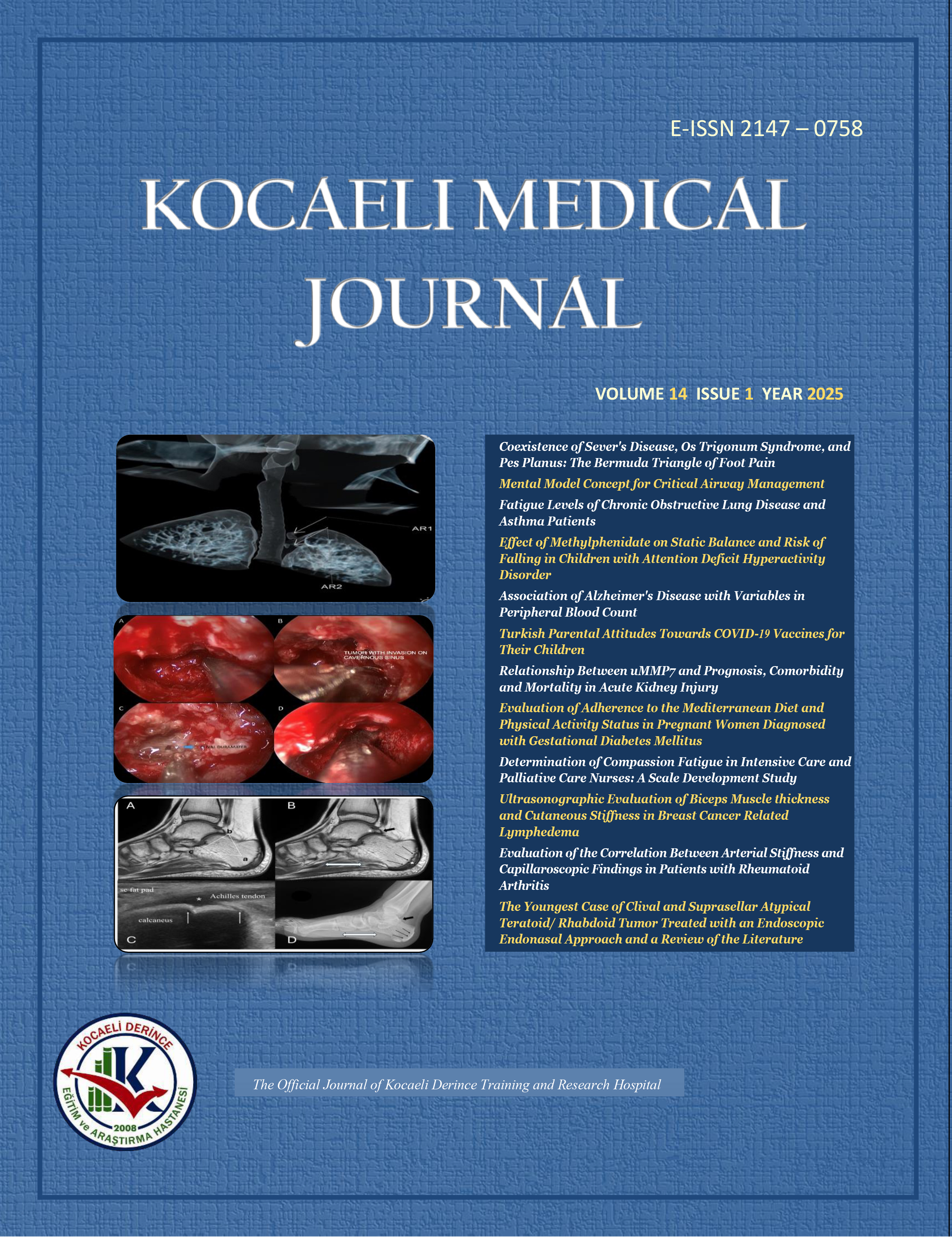
Volume: 4 Issue: 1 - 2015
| ORIGINAL ARTICLE | |
| 1. | Correlation between the amount of extracted tissue and PSA levels patients treated with transurethral resection of the prostate and transvezical prostatectomy Emre Can Polat, Levent Ozcan, Alper Otunctemur, Emin Ozbek, Şinasi Yavuz Önol Pages 1 - 4 INTRODUCTION: To investigate the correlation between extracted tissue amount and prostate specific antigen (PSA) decline in patients treated with transvesical prostatectomy (TVP) and transurethral resection of prostate (TURP). METHODS: A total of 79 patients who underwent TVP and 135 patients who underwent TUR-P with histopathologically, diagnosis of BPH was confirmed were enrolled to the study. The mean age of patients was 68.2 years in TVP group and 65.7 years in TURP group. All patients had DRE, serum total and free PSA, TRUS, uroflowmeter, and IPSS before the operation. In the postoperative 3rd month, the PSA measurement was repeated, and the correlation between the decrease in total and free PSA levels and the amount of tissue resected during the procedure was investigated. RESULTS: In TVP group mean enucleated prostate volume was 81.4%. The decrease in total and free PSA levels was 79% and 58%, respectively. In TURP group mean resected prostate volume was 52%. The decrease in total and free PSA levels was 47% and 42%, respectively (p<0.001). For 1 g of prostate mass enucleated in TVP group, the total and free PSA levels decreased 0.145 ng/ml and 0.03 ng/ml, respectively. In TURP group for 1 g of prostate mass resected, the total and free PSA levels decreased 0.103 ng/ml and 0.013 ng/ml, respectively. DISCUSSION AND CONCLUSION: Total-free PSA levels decrease with the amount of tissue extracted during TURP in BPH patients. |
| REVIEW ARTICLE | |
| 2. | The factors affecting parathyroid hormone measurement results in chronic kidney disease Buket Kın Tekçe Pages 5 - 12 Parathyroid hormone (PTH) is a polypeptide hormone produced and secreted by parathyroid glands, which plays a central role in calcium-phosphorus homeostasis. Calcium and phosphorus metabolism deteriorates in patients with chronic kidney disease (CKD) as a consequence of impairment in renal function. Deterioration in renal functions lead to an increase in serum PTH levels. Wide clinical spectrum pathologies of PTH and mineral metabolism disorders occurred in CKD is so called mineral and bone disorder of CKD (CKD-MBD). CKD-MBD is diagnosed and followed up by measurement of serum PTH. However, PTH assays are not been standardized. Causes of variations in PTH measurements include different methods, PTH derived products in serum, vitamin D level, heat, factors contributing sample obtaining and processing. Therefore, there is need for standardization of PTH measurements. Also assay-specific decision limits are required.The clinical laboratories must inform nephrologists of the actual assay method in use and report any change in methods, sample source, and handling specifications to facilitate an appropriate interpretation of biochemistry data.It clearly shows a large variability among PTH measurement kits and potential limits of this measure. Moreover, the report must indicate the correct reference values. This paper summarizes the current state regarding the PTH measurement in CKD. |
| 3. | Approach to hypogonadotropic hypogonadism cases: infertility treatment and long-term management Pınar Solmaz Hasdemir, Hasan Terzi, Semra Oruç Koltan Pages 13 - 18 Purpose: Hypogonadotropic Hypogonadism (HH) is a condition of GnRH or Gonadotropin deficiency. The aim of this study was consideration of the reasons, mechanisms, diagnosis and management of HH. Material and Methods: The key words of hypogonadotropic hypogonadism, infertility and anovulation entered to PubMed and Scopus database centers. The related articles summarized in this review. Results: HH is the situation of the lessens of the Gonadotropin Releasing Hormone (GnRH) release from hypothalamus or the inadequate response of the hypophys to the GnRH stimulation. HH comprises 5-10% of the anovulatory women. Two subgrupes defined as primary and secondary types. The genetic basis is important for he primary type. Fertility is possible with proper diagnosis and gonadotropin supportive treatment. Conclusion: HH is characterised by the low blood levels of sex steroids resulted from the low or improper levels of gonadotropins. Attentive and early diagnosis of HH could prevent the negative psychological and physical sequeles and facilitates the normal bone mass and the restoration of fertility. |
| LETTER TO THE EDITOR | |
| 4. | Sayın Editör: Diyabetik Kronik Böbrek Hastalığında Ortalama Trombosit Hacmi Erkan ŞengülPages 19 - 20 Abstract | |
| CASE REPORT | |
| 5. | Unruptured Giant Iliac Artery Aneurysm Hakan Parlar, Serpil Mevriye Diler, Doğu Fatih Geyik, Halime Özbek Pages 21 - 24 In this case report we reported that the patient who was 85-year-old man with pain in the right lower quadrent and groin, as well as presented with a complaint of a palpable mass. We performed surgical repair to the right common iliac artery and bilateral femoral artery aneurysms by using dacron graft. |
| 6. | A Rare cause of acalculous cholecystıtıs: Gallbladder tumor Fatih Mehmet Yazar, Seyfi Emir, Özgen Arslan Solmaz Pages 25 - 27 Primary carcinoma of the gallbladder is the fifth most common tumor of the gastrointestinal tract. It is usually detected by directly spreading to adjacent tissues, lymphatic spreading to regional lymphnodes or dissemine metastases. A 74year-old female patient underwent cholecystectomy because of symptomatic acalculous cholecystitis. Postoperative pathologic examination of the specimen led to a diagnosis of adeno carcinoma in the wall of gallbladder. After diagnosis, this patient underwent a second operation, which was a radical cholecystectomy. Because complaints of the patient and the physical findings are nonspesific, the gold standart in diagnosis and treatment is to be always suspicious about it. In this study, our aim was to discuss adenocarcinoma in gall bladder which is encountered rarely. |
| 7. | Hydatic Cyst In The Pelvic And Sacral Region: A Case Report Semra Duran, Mehtap Çavuşoğlu, Eda Elverici, Bülent Sakman, Enis Yüksel Pages 28 - 33 Hydatid disease is a zoonotik parasitic infection caused by Echinococcus granulosus. Hydatid disease is an endemic disease in Turkey. Echinococcus cyst are found mostly in the liver and lung,but they can be located in any part of the body. Pelvic and bone involvement of echinococcosis is rarely occurs. The combination of radiologic and serologic test especially in patients living in he endemic areas contribute to the diagnosis. We describe a case of hydatid disese as a rare cause of pelvic pain |
| 8. | Tc-99m Pertechnetate Scintigraphy for Meckels Diverticulum is The Most Useful Modality: When Performed for Exact Diagnosis? Huri Tilla İlçe Pages 34 - 36 The most common cause of massive lower gastrointestinal hemorrhage is Meckels diverticulum in children. Clinical examination and nuclear imagine are main topics for diagnosis. 99mTc pertechnetate scintiscan, or so-called Meckels scan is the best noninvasive method used to diagnosis this condition when heterotopic gastric mucosa is present. Because Meckels scan is used for detecting gastric mucosa. We described the case of 3 years old boy, complained with abundan bright rectal bleeding. Meckels divericulum scintigraphy was made during active bleeding. Intermittant intraluminal extravasation was seen during procedure. Scintigraphic study should been performed during active bleeding. So ectopic gastric mucosa and active bleeding should be shown. Key Words: Meckels diverticulum, Meckels scan, active bleeding |
| 9. | Plastrone Appendicitis in the Incarcerated Hernia Sac: A Rare Case of Amyands Hernia Ali Çiftçi, Mustafa Celalettin Haksal, Murat Coşkun, Mehmet Özyıldız, Hamdi Taner Turgut, Zehra Boyacıoğlu, Selim Yiğit Yıldız, Murat Burç Yazıcıoğlu, Çağrı Tiryaki Pages 37 - 39 Hernias most commonly occur in the inguinal area and it is named as inguinal hernia. The sac of an inguinal hernia may contain intraabdominal organ such as the sigmoid colon, cecum, omentum and the appendix. An Amyands hernia, was first reported by Claudius Amyand in 1735, is a rare occurrence where the vermiform appendix is found in an inguinal hernia sac. It is most commonly found intra-operatively during a right-sided inguinal hernia repair. The incidence of an Amyands Hernia is 1% of inguinal hernias occurring most often in male patients. We present a case of incarcerated right inguinal hernia containing the plastrone appendicitis and we review the literature on this rare condition. |












